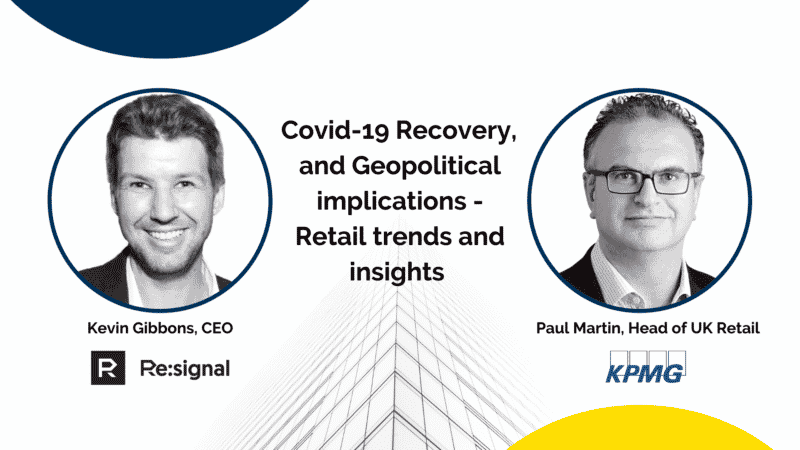Last week, Paul Martin, Global Retail Lead & UK Head of Retail at KPMG kindly joined me for a video interview to talk about the trends of the retail sector since we last discussed this in 2020, what’s to come in 2022 and where we should be focusing our attention/efforts in order to be successful.
Key themes retailers need to focus on:
1: Geopolitical implications and COVID-19 impact
- COVID-19 is still affecting large parts of the world, especially Asia – China. This is having an ongoing effect on Import/Export, Production, Supply Chain etc.
- The situation in Ukraine has also had serious supply chain implications for many retailers. In some cases, there has been a major impact on commodity pricing (e.g. Wheat and Sunflower Oil).
- A combination of these factors alongside other political developments have had a massive impact on consumer spend and behaviour. A rise in utility prices, inflation, and the cost of living has seen disposable income drop significantly. Consumers are increasingly having to compare costs against each other and budget to deal with costs continuing to rise into the near future.
- These factors will have a long term impact on the performance of many retailers for the next 12/18 months at least!
2: Cost of efficiency agenda
- Cost efficiency has become a hot topic – Food retailers are likely to have to address up to 20% of their pre-COVID cost base. For non-food retailers this could rise further, perhaps as high as 50%
- Increases in Utility Costs, Labour Costs, Supply Chain Costs, Cost of Goods over the last couple of years (and still rising)
- Businesses now need to get their house in order cost-wise over the next couple of months, to be able to cope with a situation that is likely to get worse long before it gets better! Retailers will need a range of cost levers that they are able, and prepared, to deploy as the situation worsens.
- Trading is expected to become more difficult as we move into Autumn – UK Retail Sales so far:
– Jan = +12%
– Feb = +6%
– March = +3%
– April = -0.3%
– May = -1.1%
– Situation predicted to continue to slowly decline, until August/September, when the next round of Utility price increases kick in. Then the curve is likely to be more severe (expect a brief recovery over Christmas, before another decline in 2023 Q1)
3: Global supply chain pressures
- Historically, the supply chain has been a secondary consideration for most retail leaders, but now has become more important than ever! It’s never been more crucial for businesses to have a full understanding of their end-to-end supply chain, with contingency plans if a link becomes ineffective.
4: Sustainability and environmental agenda
- Sustainability of businesses and their environmental impact has become an increasingly significant factor in buyer decisions.
- Many retailers are behind the curve on these issues!
- Retailer’s sustainability processes are being held under a microscope and critiqued.
- There is a huge need for retailers to deploy sustainable processes throughout the supply chain, and manufacturing stages, and be able to clearly demonstrate this to consumers.
- Prime opportunity for retailers to reinvent their supply chains to be more cost-effective and sustainable/environmentally friendly!
- Some retailers now seriously considering migrating to nearer-shore sourcing.
5: Channel convergence
- COVID-19 has accelerated the need to optimise channel convergence for online performance. Online Pen has gone from 18% → 30%
- Slight decline as consumers return to the high street again, but online growth is likely to continue but possibly become more seasonal.
- Consumers are now more learned and comfortable with online channels.
- Bricks vs Clicks – the answer is a hybrid of both!
- Bricks players need to open up their business plan to include online channels, and then optimise them.
6: Understanding your consumers
- Consumer behaviour has changed significantly in some cases due to COVID-19 experience!
- There is a need for retailers to invest in finding out who their customers are, and how they want to be serviced now.
- Highly likely that almost all retailers will see their consumer’s behaviours change in some way in comparison to pre-COVID behaviours.
Trends: Key categories which have experienced significant movement:
- ↑ Food/Grocery: – High growth over COVID – likely to maintain as cost of living limits people spend on eating out
- ↑ DIY/Garden/Home: – High growth over COVID – has since plateaued, but with a shift toward WFH lifestyles, the home has become more of a hub for people + rising cost of work/material etc mean that these categories are likely to sustain their high growth. These categories will likely slow down over 2022, but will maintain their higher base level in comparison to pre-COVID data.
- ↑ Apparel/Fashion: Categories – experienced a significant drop over COVID but have recovered significantly stemming from pent-up consumer demand – return of events, weddings etc. They have become the strongest performing categories in the last 3 / 4 months. This is expected to slow as we move through summer in accordance with cost of living increases.
- ↑ Fitness and Loungewear: – significant increase over COVID-19 – has sustained as consumers maintain those behaviours.
Top 3 priorities for retail leaders:
- Evolution of business models in the retail space: need to consider and adapt to changes in consumer behaviour and channel success. Retail leaders need to be aware of what is going on in the present, but also have an eye towards the future, and what is trending within the industry – e.g. Fashion retail – social commerce has become huge – TikTok
- Reviewing and optimising supply chain: in order to deal with current geopolitical/COVID-19 induced problems and squeezes, as well as conform to consumer’s sustainability agenda.
- Cost efficiency: – costs are continuing to rise, and are trending toward a continued rise – so it is important for retail leaders to address their cost base now! – Need to double down on understanding customers and then streamlining business costs to cater to their needs exactly!
Find out more in our full eCommerce SEO report.




